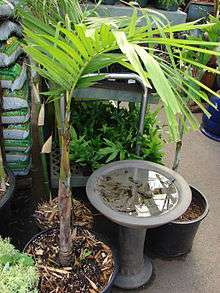Ptychosperma elegans
| Ptychosperma elegans | |
|---|---|
 | |
| Scientific classification | |
| Kingdom: | Plantae |
| Clade: | Angiosperms |
| Clade: | Monocots |
| Clade: | Commelinids |
| Order: | Arecales |
| Family: | Arecaceae |
| Genus: | Ptychosperma |
| Species: | P. elegans |
| Binomial name | |
| Ptychosperma elegans | |
| Synonyms | |
| |
Ptychosperma elegans is a very slender palm endemic to the Northern Territory and eastern Queensland in Australia.[2] It has the common names of Alexander palm,[3] Solitaire palm, cabbage palm, and elegant palm.
The palm's native habitats are coastal rainforests in northern Australia.[4]
Cultivation
Ptychosperma elegans is cultivated as an ornamental tree for planting in temperate climate gardens and parks.[5] It is a single trunked tree, that in cultivation can reach 20–40 feet (6.1–12.2 m) in height.[4]
The trunk is 1–4 inches (2.5–10.2 cm) in diameter. It is light gray or almost white, with dark leaf base scars encircling the trunk.[6]
The pinnately compound leaves or fronds can reach lengths of 6–8 feet (1.8–2.4 m) and are attached to a 1 foot (0.30 m) long petiole. They are dark green on the top and gray-green on the underside.[6]
Inflorescences produce white male and female flowers. Fruits are bright red, about one inch in diameter, and egg shaped.[4][6]
See also
- Archontophoenix alexandrae — also has Alexander palm as common name.
- Adonidia — palm genus with similar appearance.
References
- ↑ F.M. Bailey Cat. Pl. Queensland 50 1890
- ↑ "Ptychosperma elegans". Germplasm Resources Information Network (GRIN). Agricultural Research Service (ARS), United States Department of Agriculture (USDA). Retrieved 14 January 2018.
- ↑ "Ptychosperma elegans". Natural Resources Conservation Service PLANTS Database. USDA. Retrieved 15 October 2015.
- 1 2 3 Pacsoa.org.au: Ptychosperma elegans
- ↑ Dave's Garden Blog: Solitaire Palm (Ptychosperma elegans)
- 1 2 3 Palmpedia: Ptychosperma elegans
External links
- PACSOA—Palm and Cycad Societies of Australia wiki: Ptychosperma elegans (Solitaire palm) — with images
- USDA Plants Profile for Ptychosperma elegans (Alexander palm)
| Wikimedia Commons has media related to Ptychosperma elegans. |